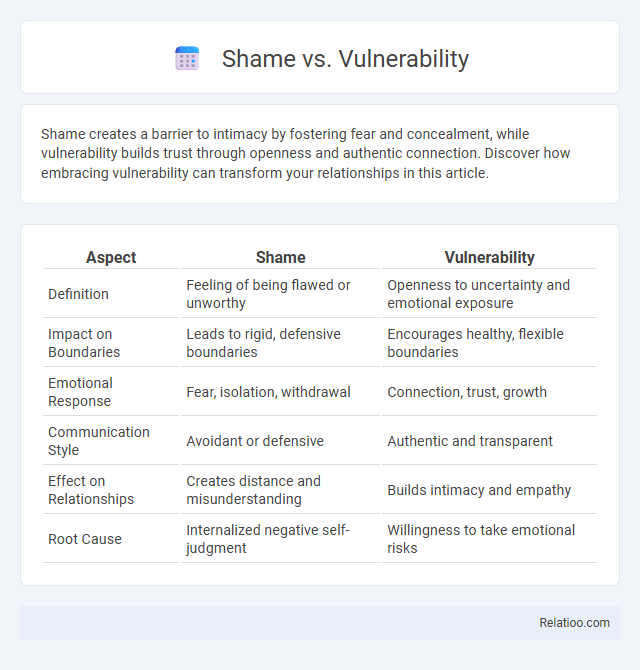Shame creates a barrier to intimacy by fostering fear and concealment, while vulnerability builds trust through openness and authentic connection. Discover how embracing vulnerability can transform your relationships in this article.
Table of Comparison
| Aspect | Shame | Vulnerability |
|---|---|---|
| Definition | Feeling of being flawed or unworthy | Openness to uncertainty and emotional exposure |
| Impact on Boundaries | Leads to rigid, defensive boundaries | Encourages healthy, flexible boundaries |
| Emotional Response | Fear, isolation, withdrawal | Connection, trust, growth |
| Communication Style | Avoidant or defensive | Authentic and transparent |
| Effect on Relationships | Creates distance and misunderstanding | Builds intimacy and empathy |
| Root Cause | Internalized negative self-judgment | Willingness to take emotional risks |
Understanding Shame: A Deep-Rooted Emotion
Shame is a deep-rooted emotion that affects your sense of self-worth and identity, often leading to feelings of inadequacy and isolation. Unlike vulnerability, which involves openness and the courage to share your true self, shame triggers a desire to hide and disconnect. Understanding shame allows you to recognize its impact on your behavior and relationships, fostering emotional resilience and self-compassion.
Defining Vulnerability: The Power in Openness
Vulnerability is the willingness to expose one's true feelings and imperfections, creating authentic connections through openness. Unlike shame, which fosters disconnection by making individuals feel unworthy, vulnerability promotes courage and empathy. Embracing vulnerability enables personal growth and strengthens relationships by encouraging trust and understanding.
Key Differences Between Shame and Vulnerability
Shame is a painful emotion stemming from the belief that you are fundamentally flawed or unworthy, often leading to isolation and self-criticism. Vulnerability, on the other hand, involves embracing uncertainty and emotional exposure, allowing you to connect authentically with others and foster resilience. Understanding these key differences helps you transform shame into vulnerability, promoting personal growth and deeper relationships.
The Origins of Shame: Social and Psychological Roots
Shame originates from social and psychological roots deeply embedded in human interactions and self-perception, where individuals internalize societal expectations and judgments. This emotion arises when a person perceives a flaw or failure that threatens their social acceptance or self-worth, often linked to childhood experiences and attachment patterns. Vulnerability, in contrast, involves openly acknowledging imperfections without the defensive barriers shame erects, allowing deeper connections and emotional resilience.
How Vulnerability Fosters Connection and Growth
Vulnerability fosters connection and growth by encouraging authentic self-expression and emotional openness, which builds trust and deepens relationships. Embracing vulnerability reduces feelings of shame, allowing individuals to confront insecurities without fear of judgment. This process promotes personal development, resilience, and stronger social bonds essential for psychological well-being.
The Impact of Shame on Mental Health and Relationships
Shame disrupts mental health by fostering feelings of worthlessness and isolation, significantly increasing the risk of depression and anxiety disorders. Unlike vulnerability, which promotes authentic connections and emotional resilience, shame leads to withdrawal and defensive behaviors, impairing relationships. Addressing shame through therapeutic interventions like cognitive-behavioral therapy enhances self-compassion and interpersonal trust, improving overall psychological well-being.
Embracing Vulnerability: Steps Toward Authentic Living
Embracing vulnerability requires acknowledging and accepting discomfort without self-judgment, allowing authentic emotions to surface. This process fosters genuine connections and resilience by transforming shame into self-compassion and growth. Practicing vulnerability involves setting boundaries, seeking support, and embracing imperfections as integral parts of human experience.
Breaking the Cycle: Overcoming Shame Through Vulnerability
Breaking the cycle of shame requires embracing vulnerability as a tool for healing and connection. Vulnerability allows individuals to confront their feelings of shame openly, fostering self-compassion and authentic communication. Research shows that practicing vulnerability reduces shame's power, promoting emotional resilience and stronger interpersonal relationships.
Real-Life Examples: Transforming Shame into Strength
Experiencing shame often leads to withdrawal and silence, as seen when someone avoids admitting mistakes at work for fear of judgment, while vulnerability involves openly acknowledging those mistakes to foster connection and growth. You can transform shame into strength by sharing personal struggles with trusted friends or mentors, turning painful feelings into opportunities for empathy and support. Real-life examples reveal that embracing vulnerability shifts the narrative from isolation to resilience, empowering individuals to overcome shame and build authentic relationships.
Cultivating Shame Resilience for a More Fulfilling Life
Shame resilience involves recognizing and confronting feelings of shame without allowing them to dictate your self-worth, fostering emotional growth and stronger connections. By embracing vulnerability, you create a safe space for authentic expression and meaningful relationships, which counteracts the isolating effects of shame. Cultivating shame resilience equips you with tools like empathy, self-compassion, and boundary-setting, essential for a more fulfilling and empowered life.

Infographic: Shame vs Vulnerability
 relatioo.com
relatioo.com